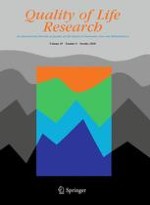01-10-2010
Invariance test of the Multidimensional Body Self-Relations Questionnaire: do women with breast cancer interpret this measure differently?
Gepubliceerd in: Quality of Life Research | Uitgave 8/2010
Log in om toegang te krijgenAbstract
Purpose
To examine whether the meaning and interpretation of body image are similar for breast cancer survivors and women without breast cancer.
Method
Women completed the Multidimensional Body Self-Relations Questionnaire—Appearance Scales as part of two studies. There were 469 women with breast cancer and 385 women without breast cancer. Invariance testing was conducted to examine whether the items assessing the body image dimensions were similar, whether the dimensions were interpreted similarly, whether the items were equally salient and meaningful, and whether there were mean differences on the body image dimensions across the two groups.
Results
The meaning and interpretation of body image dimensions related to appearance evaluation and appearance orientation were similar across the groups, yet some group differences were found for overweight preoccupation and body areas satisfaction (and not testable for self-classified weight). Breast cancer survivors reported a small yet significantly higher mean on appearance evaluation and lower mean on appearance orientation compared to the women without breast cancer.
Conclusions
Meaningful comparisons in body image across cancer and non-cancer women can be made using two of the Multidimensional Body Self-Relations Questionnaire—Appearance Scales. The overweight preoccupation subscale could be used to assess body image but should not be used if group mean differences are desirable. Assessing satisfaction with body areas across these groups is not recommended and may introduce systematic bias.
